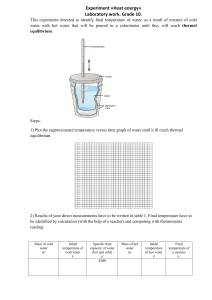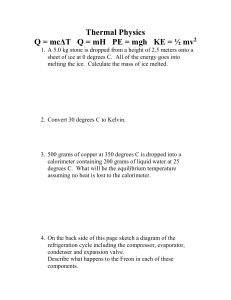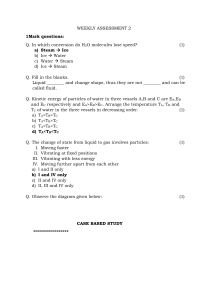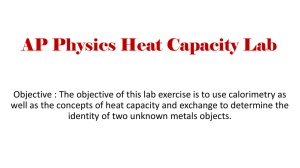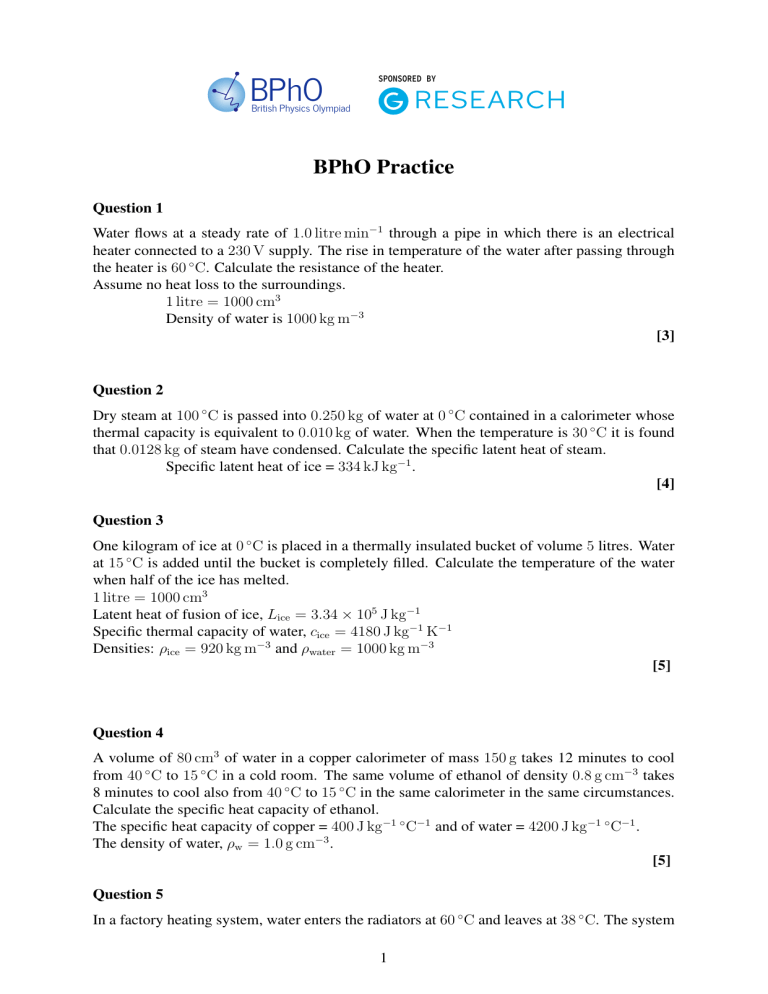
BPhO
SPONSORED BY
British Physics Olympiad
BPhO Practice
Question 1
Water flows at a steady rate of 1.0 litre min−1 through a pipe in which there is an electrical
heater connected to a 230 V supply. The rise in temperature of the water after passing through
the heater is 60 ◦ C. Calculate the resistance of the heater.
Assume no heat loss to the surroundings.
1 litre = 1000 cm3
Density of water is 1000 kg m−3
[3]
Question 2
Dry steam at 100 ◦ C is passed into 0.250 kg of water at 0 ◦ C contained in a calorimeter whose
thermal capacity is equivalent to 0.010 kg of water. When the temperature is 30 ◦ C it is found
that 0.0128 kg of steam have condensed. Calculate the specific latent heat of steam.
Specific latent heat of ice = 334 kJ kg−1 .
[4]
Question 3
One kilogram of ice at 0 ◦ C is placed in a thermally insulated bucket of volume 5 litres. Water
at 15 ◦ C is added until the bucket is completely filled. Calculate the temperature of the water
when half of the ice has melted.
1 litre = 1000 cm3
Latent heat of fusion of ice, Lice = 3.34 × 105 J kg−1
Specific thermal capacity of water, cice = 4180 J kg−1 K−1
Densities: ρice = 920 kg m−3 and ρwater = 1000 kg m−3
[5]
Question 4
A volume of 80 cm3 of water in a copper calorimeter of mass 150 g takes 12 minutes to cool
from 40 ◦ C to 15 ◦ C in a cold room. The same volume of ethanol of density 0.8 g cm−3 takes
8 minutes to cool also from 40 ◦ C to 15 ◦ C in the same calorimeter in the same circumstances.
Calculate the specific heat capacity of ethanol.
The specific heat capacity of copper = 400 J kg−1 ◦ C−1 and of water = 4200 J kg−1 ◦ C−1 .
The density of water, ρw = 1.0 g cm−3 .
[5]
Question 5
In a factory heating system, water enters the radiators at 60 ◦ C and leaves at 38 ◦ C. The system
1
is replaced by one in which steam at 100 ◦ C is condensed in the radiators, the condensed steam
leaving at 82 ◦ C. What mass of steam will supply the same heat energy as 1.00 kg of hot water
described in the first instance?
(The latent heat of vaporisation of water is 2.260 × 106 J kg−1 at 100 ◦ C. The specific heat
capacity of water is 4200 J kg−1 ◦ C−1 .)
[4]
Question 6
A pond is covered by a layer of ice 5 cm thick. How long will it be before the ice is 10 cm
thick if the air temperature stays constant at −10 ◦ C?
Assume the density of ice = 900 kg m−3 ; the latent heat of fusion of ice = 330 kJ kg−1 ; the
thermal conductivity of ice = 2.15 W m−1 K−1 .
The power flowing perpendicular to the faces through a uniform material is given by power
flow
P = λA
TH − TC
,
x
in which λ is the thermal conductivity of the material, TH is the hotter temperature at one face
of the material, TC is the colder temperature on the other face, A is the area of a face, and x is
the thickness of the material.
[7]
Question 7
A calorimeter contains 800 kg of water at a temperature of 15 ◦ C. The heat capacity of the
calorimeter is 42.8 J ◦ C−1 . 0.400 kg of molten lead is poured into the calorimeter. The final
equilibrium temperature is 25 ◦ C. What was the initial temperature of the lead?
The specific heat of molten lead is 158 J kg−1 ◦ C−1 .
The specific heat of solid lead is 137 J kg−1 ◦ C−1 .
The specific latent heat of solid lead is 2.323 × 104 J kg−1 .
Lead freezes at 327 ◦ C.
The specific heat of water is 4200 J kg−1 ◦ C−1 .
[5]
Question 8
To determine the specific heat capacity, s, of a liquid flowing at a constant rate of
0.060 kg min−1 down a pipe, heat from an electrical supply is maintained at the rate of 12 W.
It produces a temperature rise of 2.0 ◦ C along the flow. Calculate s.
[2]
2
Solutions
Question 1
Water flow [2021r1f]
The energy from the supply is equal to the thermal energy gained by the water. Assuming
V2
constant resistance, given that P =
and E = P ∆t, the energy supplied is equal to
R
E=
V2
∆t,
R
and the thermal energy gained is
Q = mc∆θ.
To find the answer, we must equate E and Q and solve for R.
V2
∆t = mc∆θ.
R
[1]
The mass of water heated in a certain time is given by m = ρ∆V , where ρ is the density of
water and ∆V is the volume of water that has been heated during that time. For this question,
let’s consider a time, ∆t of 1 minute (60 s) since we are given the volume of water that flows
through the pipe in 1 minute.
V2
∆t = ρ∆V c∆θ
R
V 2 ∆t
R=
ρ∆V c∆θ
[1]
Now we can substitute values from the question in SI or consistent units. V = 230 V; ∆t =
60 s; ρ = 1000 kg m−3 ; ∆V = 0.001 m3 ; c = 4180 J K−1 ; ∆θ = 60 K.
R=
2302 × 60
= 13 Ω
1000 × 0.001 × 4180 × 60
[1]
{3}
Question 2
Dry stream [2021r1g]
By conservation of energy,
Loss of energy of condensation + loss of energy of steam = energy gained by water and
container.
[1]
Correspondingly,
ms cw ∆Ts + ms L = mw cw ∆T + mc cc ∆T,
3
[1]
where cw is the heat capacity of water (heat capacity of steam is the same as that of water),
ms is the mass of steam and mw is the mass of water. The thermal capacity of the container,
mc cc , is equal to that of 0.01 kg of water, so we can substitute 0.01 for mc and cw for cc . ∆Ts
is the change in temperature of the steam and ∆T is the temperature change of the water and
container (they are in thermal equilibrium). L is the specific latent heat of steam. Hence, we
can simplify the expression above to
ms cw ∆Ts + ms L = mw cw ∆T + mc cw ∆T,
ms L = cw (mw ∆T + mc ∆T − ms ∆Ts ) ,
mw + mc
L = cw
∆T − ∆Ts .
ms
calorimeter included [1]
Now we can substitute given values.
0.25 + 0.01
(30 − 0) − (100 − 30) .
L = 4180
0.0128
0.25 + 0.01
L = 4180 30
− 70 = 2.25 MJ.
0.0128
[1]
{4}
Question 3
Ice melting in water [2019r1g]
First we have to find the volume of water added to the bucket. Using the definition of density,
ρ= m
, the kilogram of ice has volume
V
Vice =
m
1
= 1.087 × 10−3 m3 = 1.087 L.
=
ρice
920
[1]
Therefore, there are 5 - 1.087 = 3.913 L of water in the bucket. So the mass of water in the
bucket is m = ρwater V = 3.913 kg.
[1]
The energy transfers involved are heating 0.5 kg of ice and then 0.5 kg of water to the final
temperature, while cooling 3.914 kg of water from 15◦ C to the final temperature.
[1]
Mathematically,
mwater c∆Twater = mice Lice + mice c∆Tice.
Substituting values,
3.913 × 4180 × (15 − TF ) = 0.5 × 3.34 × 105 + 0.5 × 4180 × (TF − 0)
[1]
4180TF (0.5 + 3.913) = 3.913 × 4180 × 15 − 0.5 × 3.34 × 105
TF = 4.25 = 4.3 ◦ C.
[1]
{5}
4
Question 4
Specific heat capacity [2018r1m]
First, we assume that for the two systems at any given temperature, the cooling method is the
same so the rate of loss of thermal energy, R, is the same at that temperature. The time taken
to cool down is proportional to the thermal energy lost.
[1]
First, the total thermal energy lost by the water and calorimeter is found using E = mc∆T
and ρ = M
,
V
∆Qw+c = ρw · Vw · cw (40 − 15) + mc · cc (40 − 15).
Substituting values from the question,
∆Qw+c = 1.0 × 80 × 4.2(40 − 15) + 150 × 0.4(40 − 15),
where the specific heat capacities have been converted to J g−1 ◦ C−1 for the units to work well.
∆Qw+c = 8400 + 1500 = 9900 J.
[1]
Now the thermal energy lost by the ethanol and calorimeter,
∆Qe+c = ρe · Ve · ce (40 − 15) + mc · cc (40 − 15)
∆Qe+c = 0.8 × 80 × ce (40 − 15) + 150 · 0.4(40 − 15)
∆Qe+c = 1600ce + 1500.
[1]
Returning to the rate of cooling assumption, the water and calorimeter cool for 12 min so
∆Qw+c = 12R,
and the ethanol and calorimeter cool for 8 min which gives
∆Qe+c = 8R.
[1]
Dividing the two,
12
∆Qw+c
= .
∆Qe+c
8
Substituting the results found above,
9900
12
=
1600ce + 1500
8
79200 = 19200ce + 18000 ⇒ ce = 3.19 J g−1 ◦ C−1 = 3190 J kg−1 ◦ C−1 .
[1]
{5}
Question 5
Factory heating [2017r1g]
5
First we will find the heat released in cooling 1 kg of water using the first system.
∆QW = mc∆T
= 1 × 4200 × (60 − 38)
= 92 400 J
[1]
And now we will consider the heat released by the second system. This time, we must consider
latent heat too.
∆Qc = mL + mc∆T
= m(L + c∆T )
[1]
The question requires us to find m, given that the heat released, ∆Q is the same as in the first
system. Hence,
92400 = m 2.26 × 106 + 4200(100 − 82) .
[1]
Rearranging for m,
m=
106
2.26 ×
= 0.040 kg.
92400
+ 4200(100 − 82)
[1]
{4}
Question 6
Ice pond [2017r1r]
We have a linear heat flow model. The power flow is
P = λA
TH − TC
.
x
And given that E = P ∆t the energy transferred during a time ∆t is
E = λA
TH − TC
∆t.
x
[1]
Since the pond is already covered by a layer of ice 5 cm thick, and ice is still forming, we can
assume that the temperature of the ice is 0 ◦ C — this is TH . TC is −10 ◦ C.
We can set the energy transferred by thermal conduction in a time ∆t to be equal to the latent
heat required to convert water into ice to solve the problem.
E = mL
Since, we can m in terms of the density ρ, extra thickness of ice formed ∆x, and area of the
pond A,
E = ρA∆xL.
[1]
Hence,
λA
TH − TC
∆t = ρA∆xL,
x
6
[1]
where the x in the denominator is a finite thickness, as opposed to the ∆x, which is an
infinitesimally small quantity.
λ(TH − TC )∆t = ρx∆xL
We now need to sum over x until we reach the required extra thickness of 5 cm. If we take the
limits ∆x → 0 and ∆t → 0, then this becomes an integral.
Z x2
Z t2
x∆x
[1]
∆t = ρL
λ(TH − TC )
x1
t1
λ(TH − TC ) [t2 − t1 ] = ρL
1 2
x2 − x21
2
[1]
Rearranging for [t2 − t1 ] since this is the time required for a total thickness of 10 cm of ice to
form on top of an existing 5 cm, given that x2 = 10 cm and x1 = 5 cm.
ρL x22 − x21
[t2 − t1 ] =
2λ TH − TC
ρL ((10 × 10−2 )2 − (5 × 10−2 )2 )
=
2λ
0 − (−10)
3
= 53.0 × 10 s
= 884 minutes
= 14.7 hours
[1]
[1]
{7}
Question 7
Calorimeter [2016r1g]
The amount of heat absorbed by the water and the calorimeter, according to Q = mc∆θ and
Q = C∆θ for the calorimeter, where ∆θ for both is (25 − 15), is
Q1 = 0.80 × 4200 × (25 − 15) + 42.8 × (25 − 15)
= 34 028 J.
[1]
Now if we let Ti be the initial temperature of the lead, then the heat lost to the water and
calorimeter just before solidification is
Q2 = 0.40 × 158 × (Ti − 327)
= 63.2(Ti − 327).
[1]
And the latent heat (Q = mL) released by the lead during freezing:
Q3 = 0.40 × 2.323 × 104
= 9292 J.
[1]
The heat lost by lead after solidification until 25◦ :
Q4 = 0.40 × 137 × (327 − 25)
= 16 549.6 J.
7
[1]
All of the energy lost by lead is gained by the water and calorimeter, so
Q1 = Q2 + Q3 + Q4 .
Substituting,
34028 = 63.2(Ti − 327) + 9292 + 16549.6,
34028 − 9292 − 16549.6
Ti = 327 +
,
63.2
Ti = 457◦ .
[1]
[5]
Question 8
Specific heat capacity of moving liquid [2012r1g]
We can consider E = mc∆T . Differentiating,
d(mc∆T )
dE
=
dt
dt
dE
dm
=
c∆T.
dt
dt
[1]
,
so
we
have
related
power
to
the
mass
flow
rate
given
in
Notice that power is given by P = dE
dt
the question, as well as specific heat capacity and change in temperature.
The mass flow rate of the liquid can be converted from kg min−1 to kg s−1 ,
0.060
dm
=
= 0.0010 kg s−1 .
dt
60
Substituting power, mass flow rate, change in temperature and specific heat capacity s into the
equation found above,
12 = 0.0010 × s × 2.0
12
= 6.0 × 103 J kg−1 .
s=
0.0010 × 2.0
[1]
{2}
8
